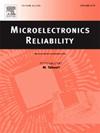Accelerated flowers of sulfur test method for power semiconductor modules
IF 1.9
4区 工程技术
Q3 ENGINEERING, ELECTRICAL & ELECTRONIC
引用次数: 0
Abstract
In humid sulfur-bearing gas application environments, power semiconductor modules can be susceptible to a corrosion failure mechanism consisting of electrically conductive copper sulfide dendrite filaments formed within insulation trenches leading to electrical shorting. A simple, safe, and low-cost corrosion test method is presented here for reliability testing for this type of failure mechanism. The test method is based on a modified version of ASTM B809–95 that was first reported for use on sulfur resistant thick film chip resistors. Here, the test was further modified to include DC voltage for accelerated reliability testing of commercially available power semiconductor modules. It is shown that the field corrosion failure mechanism can be replicated by this accelerated test within as little as 120 h in fully populated commercial modules and can discern comparative susceptibility of packaging between manufacturers. This test method adds to the collection of accelerated corrosion tests previously reported for investigation of the dendritic filament corrosion failure mechanism and stands as an option that is less complex and less toxic. A three-stage hypothesis for the corrosion dendritic failure mechanism is also presented.
功率半导体模块加速硫花试验方法
在潮湿的含硫气体应用环境中,功率半导体模块可能容易受到腐蚀失效机制的影响,该机制由绝缘沟槽内形成的导电硫化铜枝晶细丝组成,导致电短路。本文提出了一种简单、安全、低成本的腐蚀试验方法,用于此类失效机理的可靠性试验。该测试方法基于ASTM B809-95的修改版本,该版本首次报道用于耐硫厚膜片式电阻器。在这里,测试被进一步修改为包括直流电压,以加速商用功率半导体模块的可靠性测试。结果表明,现场腐蚀失效机制可以通过这种加速试验在短短120小时内在完全填充的商业模块中复制,并且可以辨别制造商之间包装的相对敏感性。该试验方法增加了先前报道的用于研究枝晶细丝腐蚀失效机制的加速腐蚀试验集合,并作为一种不太复杂和毒性较小的选择。提出了腐蚀枝晶破坏机制的三阶段假设。
本文章由计算机程序翻译,如有差异,请以英文原文为准。
求助全文
约1分钟内获得全文
求助全文
来源期刊

Microelectronics Reliability
工程技术-工程:电子与电气
CiteScore
3.30
自引率
12.50%
发文量
342
审稿时长
68 days
期刊介绍:
Microelectronics Reliability, is dedicated to disseminating the latest research results and related information on the reliability of microelectronic devices, circuits and systems, from materials, process and manufacturing, to design, testing and operation. The coverage of the journal includes the following topics: measurement, understanding and analysis; evaluation and prediction; modelling and simulation; methodologies and mitigation. Papers which combine reliability with other important areas of microelectronics engineering, such as design, fabrication, integration, testing, and field operation will also be welcome, and practical papers reporting case studies in the field and specific application domains are particularly encouraged.
Most accepted papers will be published as Research Papers, describing significant advances and completed work. Papers reviewing important developing topics of general interest may be accepted for publication as Review Papers. Urgent communications of a more preliminary nature and short reports on completed practical work of current interest may be considered for publication as Research Notes. All contributions are subject to peer review by leading experts in the field.
 求助内容:
求助内容: 应助结果提醒方式:
应助结果提醒方式:


